It doesn’t look like much. The latest Roland Boutique might even give you a sense of deja vu – because Roland did a tiny JUNO before. The difference: this time they got it right.
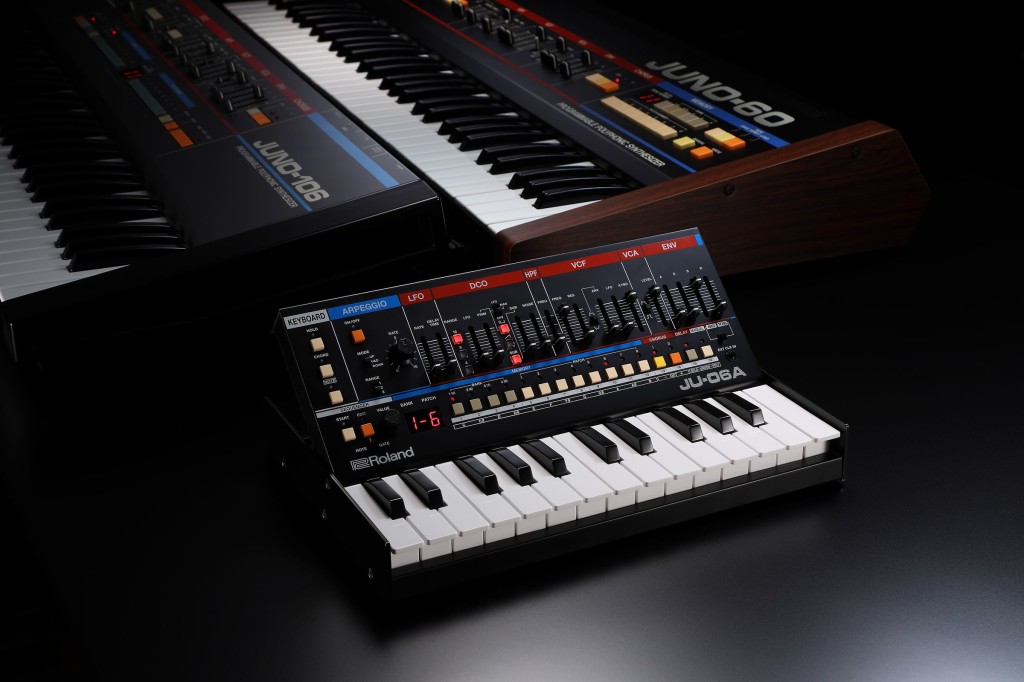
I’m the last person to want endless remakes of old synths. But a JUNO is something special. I assume I’m not alone in this – if I’m in someone else’s studio and there’s a JUNO-106 or JUNO-60 lying around, I’ll usually say let’s plug in that. It’s not even necessarily that they’re my favorite analog polysynths; it’s that something about them has a unique ability to blend into a mix, and be versatile in a number of situations. It’s also a pleasant early 80s sound that seems to blend well with more contemporary timbres, too. (I’ve found plenty of other artists who seem to feel similarly, ones whose opinion you should probably value more than mine, so I don’t feel I’m going out on a limb.)
Okay, so a JUNO is something you just want handy. And you don’t want it to be a plug-in – that’s terrible for jam sessions and live. The full keyboard is now pricey on the used market, takes up a lot of space, and is now at an age when it starts to break down. (I’m a few years older than these Rolands, and I start to feel their pain. Literally. I look forward to the digital remake of me.)
So you do really want an inexpensive hardware remake.
You would then presumably want it to be small and portable, so you can always keep it around.
You’d want it to still sound like a JUNO.
You’d want it to be playable, so you could use it as a sketchpad or easily work it into jams and live sets.
You wouldn’t want it to be terribly expensive.
The JU-06 that launched this whole oddly-named Roland Boutique phenomenon almost got this right, but then mostly screwed it up. There’s a step sequencer, but no external clock in. (There’s MIDI clock in, just not analog clock in.) It’s overly authentic in that modulation isn’t tempo synced – even though it’s now a MIDI device. There’s a step sequencer, but it shares the same buttons as the patch controls, a guarantee that you’ll wind up accidentally changing patches at an inopportune moment.
It sounds good, like a JUNO-106. But lots of things sound good now – and the JU-06 was mediocre enough that you start to go back to the thought that maybe a plug-in isn’t such a bad idea.
Roland are now back with the JU-06A, and not only does it fix all the issues with the JU-06, but I think it’s just edged out the SH-01A as the Boutique synthesizer I would buy first.
Price US$399, available this month.
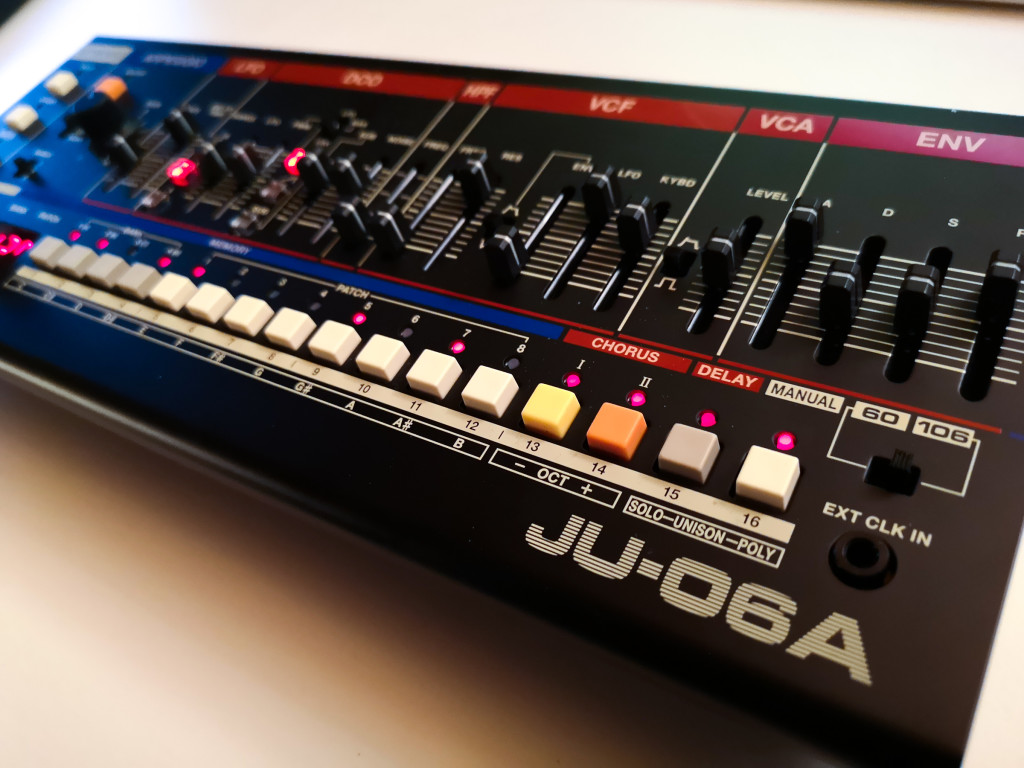
Everything is fixed now
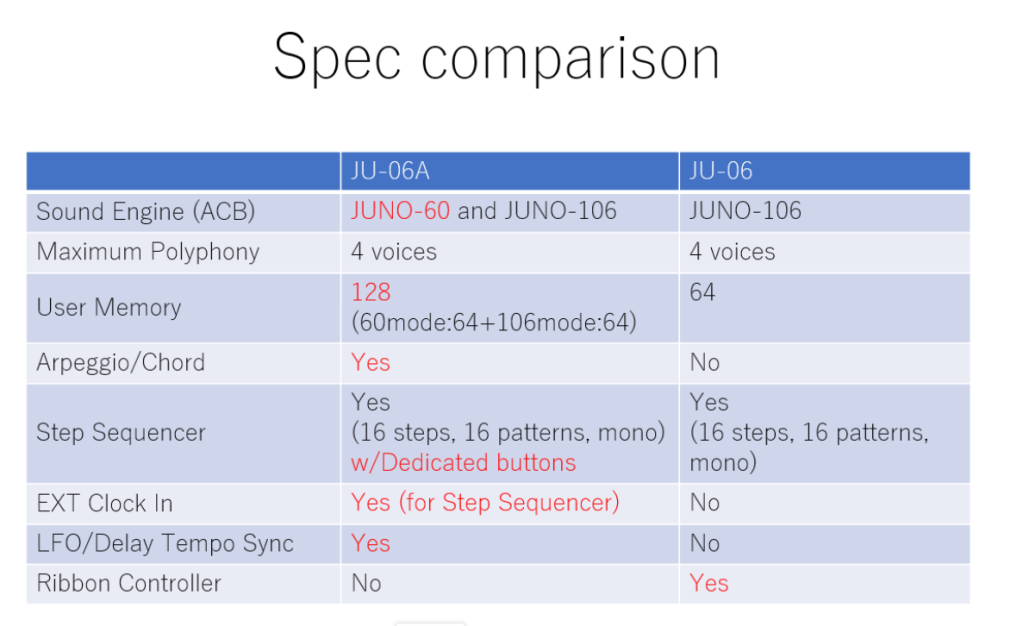
The JU-06A doesn’t look radical, but little differences make this something you want to keep rather than return.
JUNO-60, too. Inside, Roland have added a second sound engine to emulate the 1982 JUNO-60, as well as the 1984 JUNO-106. There’s a toggle switch on the front panel that lets you swap models – an advantage of going digital. As with the other Boutiques (apart from the Studio Electronics collaboration), this is circuit modeling (ACB). But it sounds terrific.
Adding the JUNO-60 adds some more idiosyncratic sound options. In addition, you can reproduce the noise of the vintage chorus (with parameters tucked in settings for off/half/full noise). There are lots of other details that give this tiny box some of the growl and warmth of the original and its filter without taking up much space. Someone I’m sure will do some obsessive comparison, but it’s uncanny enough to be fine in a mix.
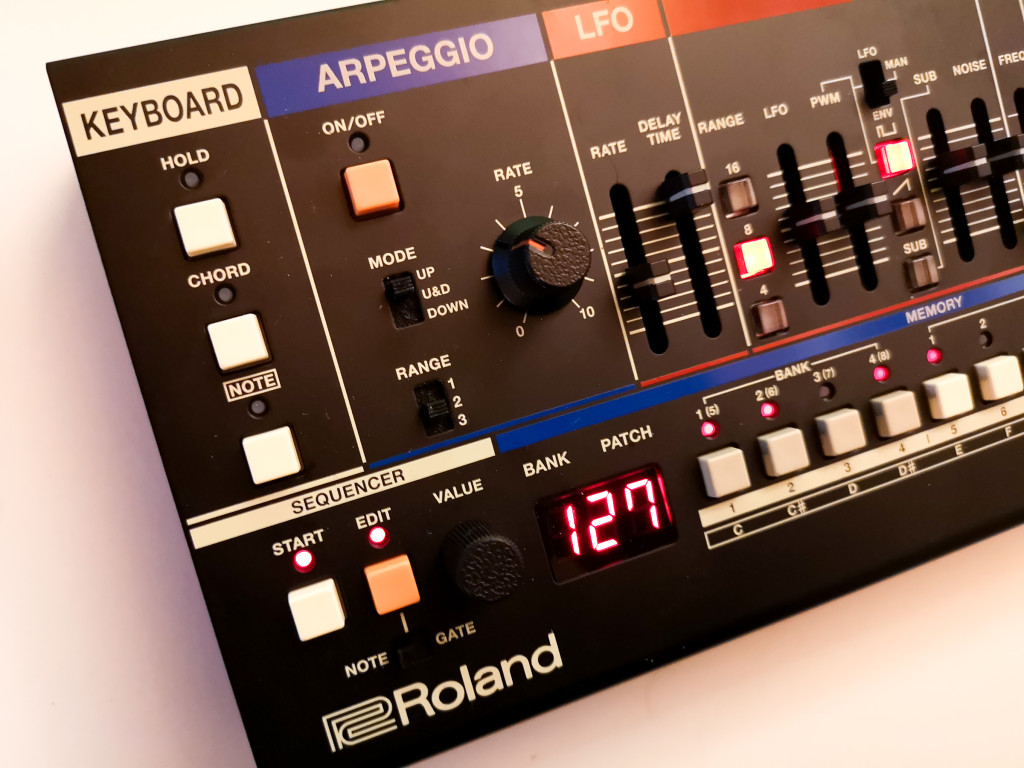
Chord and arpeggiator modes. This makes a major difference in playability. There are now simple chord playback and arpeggiator controls on the left-hand side of the unit, replacing the mostly pointless touch strip pitch and mod. Chord mode is lovely on a poly, of course; you get just 16 slots for chords, but that’s about the amount I can remember, anyway. Each memory slot can be edited from the front panel.
The arp is similarly basic but useful – you get up, down, and up/down modes, a range (from 1-3 octaves), and a rate knob, which always divides the master clock. It’s pretty basic, but all the controls are dedicated, which is great live.
There’s also a dedicated HOLD button, and the arp will work with both the HOLD and CHORD modes.
On its own, that would still be too limiting, but fortunately there’s also —
A step sequencer. 16 steps times 16 patterns, all monophonic. And now this also works with external clock – there’s a little minijack next to the sequencer itself (odd positioning, but it works).
The step sequencer is surprisingly usable, with practice, on the front panel. You can switch steps on and off, TR x0x style, and also enter in steps one at a time from the onboard keyboard. You can also use an external keyboard for pitch entry – like the Roland Boutique keyboard dock, or something else via MIDI in.
What’s evidently missing, which was on the SH-01A, is the ability to add individual chords to steps. That’s too bad, though what you get instead is, the monophonic step sequencer becomes the root note of the chord when chord mode is on.
LFO and Delay Tempo Sync. Both the LFO and Delay effect can now be clocked free, or synced to the master tempo. That’s obvious, but for some reason the JU-06 lacked it.
There’s more user memory. You get both 64 dedicated slots for each mode – JUNO-60 and JUNO-106 – which doubles the slots on the JU-06, and lets you effectively keep a library for each instrument.
The Ribbon Controllers are gone. If you particularly desire touch strips for pitch and mod, you should pick up a used JU-06 and not this. I don’t miss them, though, and I think most people will vastly prefer the chord and arp.
But it’s still 4-voice. Presumably because of limitations on the internal digital architecture, the JU-06A like the JU-06 is 4-voice, not 6-voice like the originals. On the other hand, it’s only $399, and it’s a fun, little box – not a full-sized keyboard like the original – so this kind of makes sense.
In practice, why you might not notice? That’s easy – this remains a decent monosynth, using the mono or unison mode, both of which also sound great with the chorus. And if you are using a mini keyboard or even the step sequencer and onboard keys, odds are you aren’t making 6-note chords.
So, basically, if you want a sound module to use as a poly with your keyboard, this probably isn’t for you. But for everyone else – using mini keys, sequencer, arp, and chord mode – 4-voice fits fine.
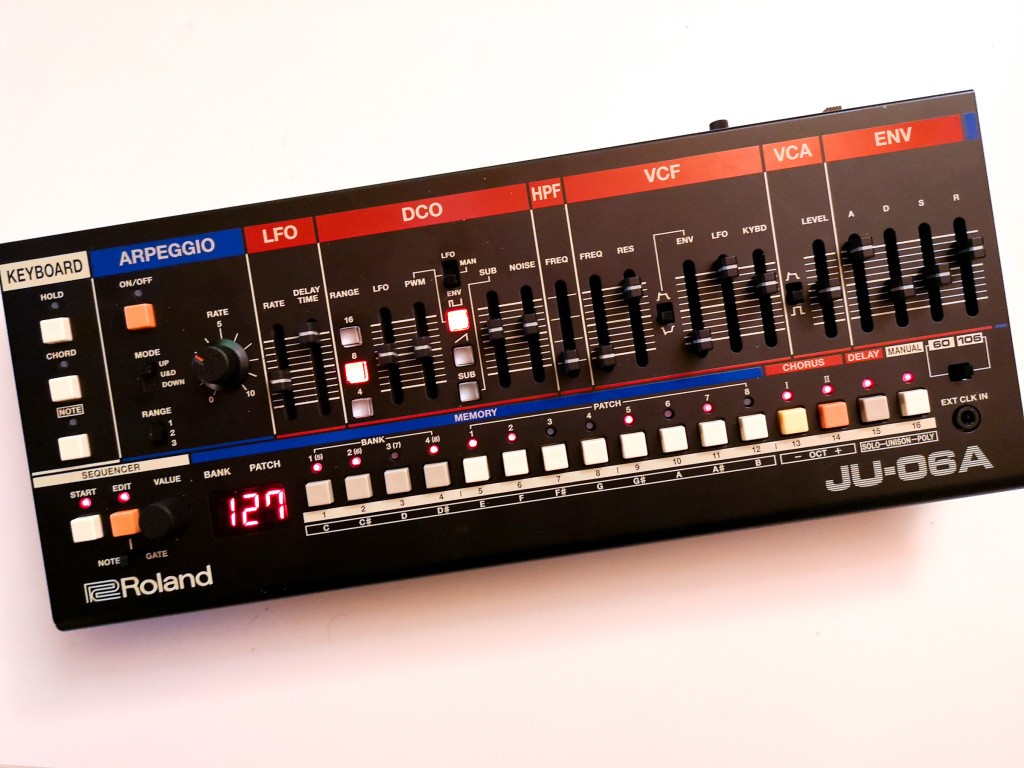
Fun in use for fans of tiny things
If I had one gripe about the JU, it’s the ongoing Boutique form factor. These units are compact and lightweight, but there’s still this strange docking scheme. That lets you choose either a keyboard or a little box that lets you tilt up the unit. (That’s the DK-01 docking station and the K-25m keyboard dock.) They each run a little under $100 street, with the keyboard costing more.

The upside is, of course, if you buy multiple Boutiques they don’t all have to have keyboards. But they do make you feel like Roland is squeezing you for extra cash (well, because they are), and the impression of the actual design is sort of toylike. My JU-06A review unit came without either, and my delicate aesthetic sensibilities made me not want to dock it in the silver 303 or beige 909 docks I had around, so I found… okay, actually, the thing is even more portable and lightweight without it, is still usable, and just has some funny edges. In an ideal world, this would have USB host so you could plug in anything; in this world, I’d probably still use a different keyboard and not the keyboard dock.
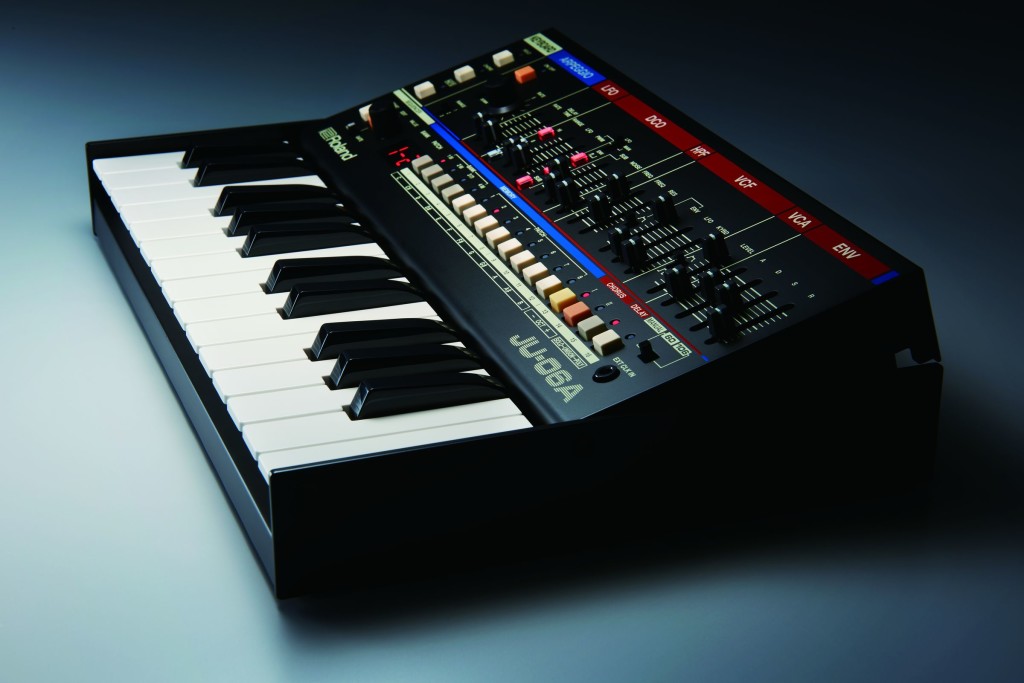
But I got over it. I love tiny things. The JU is small enough to fit in your backpack, and since it’s battery powered, you can sprawl in bed and program nice step sequences for a gig the next day.
This thing is definitely Japanese in scale – the land that miniaturized electronics in the first place. So if your fingers fit comfortably on tiny controls, you’ll love it. If not, you’ll (justifiably) hate it.
Assuming you can handle it, though, I think the JU-06A is a total joy. I took it to a jam session with some studio neighbors and a live club gig (disguising the unreleased hardware’s identity), and it excelled in both cases – enough that people clearly responded to the sound.
The step sequencer would definitely benefit from parameter locks, but then maybe that isn’t the way to think of the JUNO. With the stupid-simple step sequencer, chords, and arp, you can just go wild with the (tiny) LFO and (tiny) envelope controls and (tiny) filter, and this thing is a performance beast.
I’m sure I’ll get some pushback from people who think it’s still a toy, who hate that it’s digital, who are interested in a certain clone manufacturer rather than the company that did the first JUNO. But no matter. This thing is still affordable, it’s got loads of controls, the sound engine is clearly good enough, and the digital aspect makes it practical, flexible, and power efficient.
It’s not the only compact remake poly in town – the Yamaha reface cs is now running about $300 street, with a keyboard. But the JU-06A to me is now an ideal addition.
So yeah, Roland I should… probably let you know I’m keeping this one.
Updated – there already is a 1:1 comparison.
Spoiler alert: even if your music involves slowly playing individual keys and listening to parameter changes as you gradually shift faders, repeatedly, with both a JUNO-06A and JUNO 60 side by side, you still probably won’t notice a significant difference.
If your music involves anything more interesting than that (and, not to judge, but I sincerely hope so), it makes absolutely no difference.
Even this comparison is somewhat unfair, as the whole point of vintage analog gear is that there are subtle differences in how individual units sound.
Can you tell the difference between a JUNO-60 and JU-06A? Yes. Observe whether they have full size keyboards. Put them inside two identical shoeboxes – the fit will be more snug on one than the other. Lift them with one hand.
Listen to them, double blind? No, it’s not particularly important that the Boutique is digital.